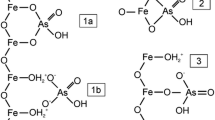Abstract
In pyritic environments, the bacteriaThiobacillus ferrooxidans catalyze acid formation by increasing the oxidation rate of pyrite by a factor of one million. This acid solubilizes metals and pollutes adjacent streams and lands. Bactericide sprays during mining and waste disposal operations attack the source of the problem by preventing acid formation and metals solubilization. Used in conjunction with current water treatment systems, bactericides can dramatically reduce operating costs. Controlled release bactericides contribute to successful reclamation by providing assurance against revegetation failure and post-reclamation water quality problems that can necessitate perpetual water treatment. While inhibitingT. ferrooxidans these organic compounds aid in the establishment of beneficial heterotrophic bacteria which support vegetation. These conditions continue to persist after the bactericide is depleted from the controlled release system. Case Studies I and II show that bactericides inhibit acid generation during hard rock and coal mining operations and they are cost effective. Case Studies III and IV illustrate the improvement in water quality and vegetation after reclamation when controlled release bactericides were used. Economic analyses show cost benefits are achieved when controlled-release bactericides are part of the reclamation plan.
Similar content being viewed by others
References
Beck, J. V. and Brown, D. C. (1968). Direct sulfide oxidation in the solubilization of sulfide ores byThiobacillus ferrooxidans. Journal of Bacteriology, Vol. 96, pp 1433–1434.
Benedetti, D. A., Rastogi, V., and Sobek, A. A. (1990). Minimizing water treatment costs at active operations. Proceedings of the National Symposium on Mining, Knoxville, TN.
Dychdala, R. (1968). Acid-anionic surfactant sanitizers,Disinfection, Sterilization, and Preservation. pp 253–256, Lea and Febiger, PA.
Horowitz, A., Bacskay, J. J., and Gordon, B. M. (1988). Enumeration ofThiobacillus ferrooxidans from mine refuse material. Internal Technical Report, The BFGoodrich Company, Akron, Ohio.
Kleinmann, R. L. P., Crerar, D. A., and Pacilli, R. R. (1981). Biogeochemistry of acid mine drainage and a method to control acid formation. Mining Engineering, pp 300–304.
Onysko, S. J., Kleinmann, R. L. P., and Erickson, P. M. (1984). Ferrous iron oxidation byThiobacillus ferrooxidans: inhibition with benzoic acid, sorbic acid and sodium lauryl sulfate. Applied and Environmental Microbiology, Vol. 28, No. 1.
Rastogi, V. and Sobek, A. A. (1986). The economics of using bactericides in active mining and in reclamation to control, acid mine drainage. Proceedings of the National Symposium on Mining, Hydrology, Sedimentology, and Reclamation, University of Kentucky, Lexington, KY, pp 215–220.
Schnaitman, C. A., Korczynski, M. S., and Lundgren, D. G. (1969). Kinetic studies of iron oxidation by whole cells ofFerrobacillus ferrooxidans. Journal of Bacteriology, Vol. 99, pp 552–557.
Shellhorn, M. A. and Rastogi, V. (1984). Laboratory methods for determining the effects of bactericides on acid mine drainage. Proceedings of the Symposium on Surface Mining, Hydrology, Sedimentology and Reclamation, University of Kentucky, Lexington, KY, pp 77–86.
Sobek, A. A., Benedetti, D. A., and Rastogi, V. (1990). Successful reclamation using controlled release bactericides: two case studies. Proceedings of the American Society for Surface Mining and Reclamation Conference, Charleston, WV, pp 33–42.
Sobek, A. A., Schuller, W. A., Freeman, J. R., and Smith, R. M. (1978). Field and laboratory methods applicable to overburdens and mine soils. EPA 600/2-78-054, U. S. Environmental Protection Agency, Cincinnati, OH.
Tuttle, J. H., Dugan, P. R., and Apel, W. A. (1977). Leakage of cellular material fromThiobacillus ferrooxidans in the presence of organic acids. Applied and Environmental Microbiology, Vol. 33, pp 459–469.
U. S. Congress (1978). Federal insecticide, fungicide, and rodenticide act as amended. Public Law 92-516, October 21, 1972, as amended by Public Law 94-140, November 28, 1975, and Public Law 95-396, September 30; 1978, 86 Stat. 973–999.
Author information
Authors and Affiliations
Rights and permissions
About this article
Cite this article
Sobek, A.A., Rastogi, V. & Benedetti, D.A. Prevention of water pollution problems in mining: The bactericide technology. International Journal of Mine Water 9, 133–148 (1990). https://doi.org/10.1007/BF02503688
Issue Date:
DOI: https://doi.org/10.1007/BF02503688




